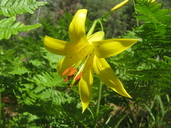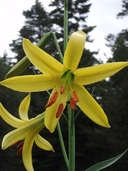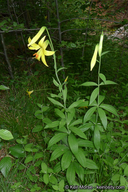Taxon Details
Lilium parryi
lemon lily
View Report Copy Link Calflora eFlora CCH CalPhotos iNaturalist
Taxon Summary:
Lilium parryi, commonly known as lemon lily, is a perennial bulbiferous herb in the Liliaceae that is found in California and elsewhere. It occurs within Lower montane coniferous forest, Meadows and seeps, Riparian forest, and Upper montane coniferous forest, growing at elevations from 1220 to 2745 meters. Lilium parryi is ranked 1B.2, Plants Rare, Threatened or Endangered in California and Elsewhere; Moderately threatened in California.|
Scientific Name: Lilium parryi Wats. |
||
|
Common Name: lemon lily |
||
| Family: | Liliaceae | |
| Element Code: | PMLIL1A0J0 | |
| USDA Plants Symbol: | LIPA2 | |
|
Synonyms/Other Names: |
||
| Name Status: |
JEF, FNA, POWO, IPNI, Tropicos |
|
| CA Rare Plant Rank: | 1B.2 |
| Fed List: | None |
| State List: | None |
| Global Rank: | G3 |
|
State Rank: |
S3 |
| Other Status: | SB_CalBG/RSABG; SB_CRES; USFS_S |
|
CRPR Changes: |
|
| Add Date: | 1974-01-01 |
| Date Edited: | 2025-10-29 |
| Lifeform: perennial bulbiferous herb | ||||||||||||||
Blooming Period: Jul-Aug
|
||||||||||||||
|
Elevation:
1220 - 2745 meters 4005 - 9005 feet |
||||||||||||||
General Habitats:
|
||||||||||||||
| Microhabitat Details: | ||||||||||||||
Microhabitat:
|
||||||||||||||
|
Notes: Most occurrences in LAX Co. are very small. Nearly extirpated from SDG Co., where known from only a few plants at Palomar Mtn. SP. Threatened by horticultural collecting, water diversion, recreational activities, and grazing. Includes L. parryi var. kessleri. Angeles NF has adopted species management guidelines. See Madroño 40(4):270-271 (1993) for first Mexico record and distributional information. |
|
|
Threats: |
|
|
Taxonomy: |
|
| Threat List Total: | 16 | |
| Total EOs | % of EOs | |
| EOs with Threat Listed: | 62 | 39 % |
| THREAT LIST: | ||
|---|---|---|
| Foot traffic/trampling | 28 | 17% |
| Recreational use (non-ORV) | 19 | 11% |
| Road/trail construction/maint. | 19 | 11% |
| Over-collecting/poaching | 17 | 10% |
| Other | 12 | 7% |
| Vandalism/dumping/litter | 7 | 4% |
| Erosion/runoff | 6 | 3% |
| Wood cutting or brush clearing | 4 | 2% |
| Surface water diversion | 3 | 1% |
| Grazing | 3 | 1% |
| Improper burning regime | 2 | 1% |
| Non-native plant impacts | 2 | 1% |
| Development | 2 | 1% |
| Altered flood/tidal/hydrologic regime | 1 | 0% |
| ORV activity | 1 | 0% |
| Pollution | 1 | 0% |
| Total Occurrences: | 160 | ||||
| Element Occurrence Ranks: | |||||
|---|---|---|---|---|---|
| A | B | C | D | X | U |
| 8 | 26 | 7 | 4 | 4 | 111 |
| Occurrence Status: | |||||
|---|---|---|---|---|---|
| Historical >20 Years | 69 | ||||
| Recent <=20 Years | 91 | ||||
| Presence: | |||||
|---|---|---|---|---|---|
| Presumed Extant | 156 | ||||
| Possibly Extirpated | 3 | ||||
| Presumed Extirpated | 1 | ||||
| California Endemic: | |||||||||||||
| California Island: | |||||||||||||
|
States: Name (Code) Arizona (AZ), California (CA), Sonora, Mexico (SO) |
|||||||||||||
|
California Counties and Islands: Name (Code) Los Angeles (LAX), Riverside (RIV), San Bernardino (SBD), San Diego (SDG) |
|||||||||||||
|
Quads: Name (Quad Code) Big Bear Lake (3411628), Boucher Hill (3311638)*, Butler Peak (3411731), Crystal Lake (3411737), Cucamonga Peak (3411725), Cuyamaca Peak (3211685)*, Devore (3411724), Fawnskin (3411638), Forest Falls (3411618), Idyllwild (3311666), Julian (3311615), Juniper Hills (3411748), Keller Peak (3411721), Lake Arrowhead (3411732), Lake Fulmor (3311677), Moonridge (3411627), Mount San Antonio (3411736), Mt. Baldy (3411726), Onyx Peak (3411626), Pacifico Mountain (3411841), Palm Springs (3311675), San Gorgonio Mtn. (3411617), San Jacinto Peak (3311676), Sitton Peak (3311754), Telegraph Peak (3411735), Toro Peak (3311654), Tule Springs (3211686), Waterman Mtn. (3411738), Wildomar (3311753) |
|||||||||||||
Notes:
|
|||||||||||||
 Presumed Extant
Presumed Extant
Click on quad for name. Hold Shift Key to use mouse scroll wheel



